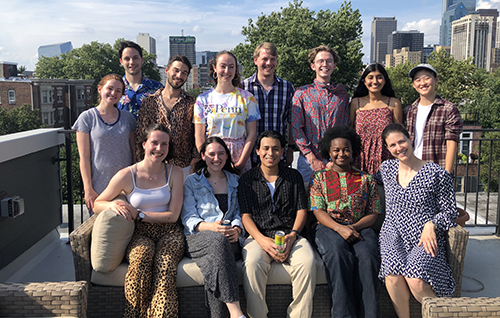
Erica Korb, Ph.D
University of Pennsylvania
The Perelman School of Medicine
Department of Genetics
9-124 Smilow Center for Translational Research
3400 Civic Center Blvd
Philadelphia, PA 19104

The role of chromatin in neurodevelopmental disorders and disease.
Epigenetic regulation plays a critical role in many neurodevelopmental disorders, including Autism Spectrum Disorder (ASD). In particular, many such disorders are the result of mutations in genes that encode chromatin modifying proteins. However, while these disorders share many features, it is unclear whether they also share gene expression disruptions resulting from the aberrant regulation of chromatin. We examined 5 chromatin modifiers that are all linked to ASD despite their different roles in regulating chromatin. Using RNA-sequencing, we identified a transcriptional signature that is shared between multiple neurodevelopmental syndromes, helping to elucidate the link between epigenetic regulation and the underlying cellular mechanisms that result in ASD.
During the COVID-19 shut-down, we sought to apply our understanding of histone biology to better understand the ability of SARS-CoV-2 to evade the immune system. In rare cases, viral proteins dampen antiviral responses by mimicking critical regions of human histone proteins particularly those containing posttranslational modifications required for transcriptional regulation. We found that the SARS-CoV-2 protein encoded by ORF8 (Orf8) functions as a histone mimic of the ARKS motifs in histone 3. Orf8 is associated with chromatin, binds to numerous histone-associated proteins, and is itself acetylated at this site. Orf8 expression disrupts multiple critical histone post-translational modifications including H3K9ac, H3K9me3, and H3K27me3 and promotes chromatin compaction while Orf8. Further, SARS-CoV-2 infection in human cells and patient lung tissue cause these same disruptions to chromatin acting through the Orf8 histone mimic motif. These findings define a mechanism through which SARS-CoV-2 disrupts host cell epigenetic regulation.
In my postdoctoral work in the lab of Dr. C. David Allis, I studied Fragile X syndrome (FXS). FXS is the most common genetic cause of intellectual disability and autism and is caused by loss of function of fragile X mental retardation protein (FMRP). I found that a disproportionate number of FMRP targets encode transcriptional regulators, particularly chromatin-associated proteins. In addition, I discovered that the loss of FMRP results in widespread chromatin misregulation and aberrant transcription. Finally, I demonstrated that the small molecule inhibitor Jq1 which blocks chromatin binding of the BET family of proteins alleviated many of the transcriptional changes and behavioral phenotypes associated with FXS. Through this work, I elucidated a novel causative mechanism of epigenetic disruption underlying FXS and demonstrated that targeting transcription may provide new treatment approaches. This work was published in Cell and included in a patent.
- Kee, J., Thudium, S., Renner, D.M., Glastad, K., Palozola, K., Zhang, Z., Li, Y., Lan, Y., Cesare, J., Poleshko, A., Kiseleva, A.A., Truitt, R., Cardenas-Diaz, F. L., Zhang, X., Xie, X., Kotton, D. N., Alysandratos, K. D., Epstein, J.A., Shi, P.Y., Yang, W., Morrisey, E., Garcia, B. A., Berger, S. L., Weiss, S. R., Korb, E. SARS-CoV-2 protein encoded by ORF8 contains a histone mimic that disrupts chromatin regulation. Nature. (PMC in progress)
- Thudium S, Palozola K, L’Her E, Korb E. Identification of a transcriptional signature found in multiple models of ASD and related disorders. Genome Research. (PMC in progress)
- Korb, E., Herre, M., Zucker-Scharff, I., Allis, C.D., Darnell, RB. 2017. Excess translation of epigenetic regulators contributes to Fragile X Syndrome and is alleviated by Bd4 inhibition. Cell. (PMC5740873)
- Inquimbert, P., Moll, M., Latremoliere, A., Tong, C.K., Wang, J., Sheehan, G.F., Smith, B.M., Korb, E., Athie, M.C.P., Babaniyi, O., Ghasemlou, N., Yanagawa, Y., Allis, C.D., Hof, P.R., Scholz, J. 2018. NMDA Receptor activation underlies the loss of spinal dorsal horn neurons and the transition to persistent pain after peripheral nerve injury. Cell Rep. (PMC62761118)
Epigenetic regulation of information storage in the brain
While chromatin regulation is crucial for the mechanisms underlying memory formation, the role of many chromatin-associated proteins in the context of neuronal function remains unclear. During my postdoctoral fellowship, I focused on Brd4, which binds acetylated histones. Despite the increasing use of Brd4 inhibitors as therapeutics, it had never been examined in the brain. I found that specific synaptic signals which leads to enhanced binding of Brd4 to histones to activate transcription of key neuronal genes that underlie memory formation. The loss of Brd4 function affects synaptic protein content, which results in memory deficits in mice and decreases seizure susceptibility. Thus, Brd4 provides a critical and previously uncharacterized link between neuronal activation and the transcriptional responses that occur during memory formation. This work has implications for the use of BET inhibitors in clinical settings and in possible treatments for epilepsy.
I also contributed to work examining additional mechanisms linking epigenetic regulation of transcription to behavioral responses to experience. This work from our collaborators in the lab of Dr. Eric Nestler (Ichan School of Medicine at Mount Sinai), examined the role of the ACF chromatin remodeling complex in depression. I investigated mechanisms controlling activity-dependent changes in expression of ACF. Together, these projects advanced our understanding of the link between neuronal signaling and epigenetic regulation underlying animal behavior both in normal conditions and in the context of mental health disorders. Finally, as an independent investigator, we published a review on the links between chromatin and plasticity mechanisms in the brain.
- Korb, E., Herre, M., Zucker-Scharff, I., Darnell, RB., Allis, C.D. 2015. BET protein Brd4 activates transcription in neurons and BET inhibitor Jq1 blocks memory in mice. Nat. Neuro. (PMC4752120)
- Herre, M., Korb, E. The chromatin landscape of neuronal plasticity. Curr. Opin. Neurobiol. (PMID: 31174107)
- Sun, H., Damez-Werno, D.M., Scobie, K.M., Shao, N., Dias, C., Rabkin, J., Koo, J.W., Korb, E., Bagot, R.C., Ahn, F.H., Cahill, M., Labonte, B., Mouzon, E., Heller, E.A., Cates, H., Golden, S.A., Gleason, K., Russo, S.J., Andrews, S., Neve, R., Kennedy, P.J., Maze, I., Dietz, D.M., Allis, C.D., Turecki, G., Varga-Weisz, P., Tamminga, C., Shen, L., Nestler. E.J. 2015. ACF chromatin remodeling complex mediates stress-induced depressive-like behavior. Nat. Med. (PMC4598281)
Linking the synapse to the nucleus.
During my graduate school research, I sought to elucidate previously unexamined mechanisms regulating learning and memory. I focused on a protein that is critical for memory formation and synaptic plasticity, the activity-regulated cytoskeletal protein. Arc expression is robustly induced by activity, and Arc protein localizes both to active synapses and the nucleus. While its synaptic function had been examined in great detail, it was not clear why or how Arc is localized to the nucleus. I identified distinct regions of Arc that control its localization, including a nuclear localization signal, a nuclear retention domain, and a nuclear export signal. Arc localization to the nucleus regulates transcription, PML nuclear bodies, synaptic strength, and homeostatic plasticity. This was the first demonstration that Arc was important in regulating transcription and one of the first indications that PML bodies play an important role in neurons.
Our lab has undertaken projects examining other pathways that link external signals to responses within the nucleus. As part of a collaboration with Dr. Steven Josefowicz at Weill Cornell Medical School, we examined a previously unexplored histone modification, histone H3.3 serine 31 phosphorylation (H3.3S31ph). We demonstrated that in neurons H3.3S31ph is rapidly and robustly induced in neurons in response to synaptic stimulation. This was critical in expanding finding to additional cell types and systems beyond an immune cell response and was recently published in Nature.
- Korb, E., Wilkinson, C. L., Delgado, R.N., Lovero, K.L., Finkbeiner, S. 2013. Arc in the nucleus regulates PML-dependent GluA1 transcription and homeostatic plasticity. Nat. Neuro. 16(7), 874-83. (PMC3703835)
- Korb, E., Finkbeiner, S. 2011. Arc in synaptic plasticity: from gene to behavior. Trends Neurosci. 34, 591-8. (PMC3207967)
- Korb, E., Finkbeiner, S. 2013. PML in the Brain: From Development to Degeneration. Frontiers in Molecular and Cellular Oncology. 17, 242. (PMC3775456)
- Armache, A., Yang, S., Martinez de Paz, A., Robbins, L.E., Durmaz, C., Yeong, J.Q., Ravishankar, A., Daman, A.W., Ahimovic, D.J., Klevorn, T., Yue, Y., Arslan, T., Lin, S., Panchenko, T., Hrit, J., Wang, M., Thudium, S., Garcia, B.A., Korb, E., Armache, K., Rothbart, S.B., Hake, S.B., Allis, C.D., Li H., Josefowicz, S.Z. 2020. Histone H3.3 phosphorylation amplifies stimulation-induced transcription. Nature. 583(7818), 852-857. (PMC75175895)
Research Interest
The Korb lab works at the intersection of neuroscience and epigenetics. Epigenetic regulation is extremely important in neuronal function and contributes to the creation of new memories, our ability to adapt to our environment, and numerous neurological disorders. We try to understand how the world around us can influence gene expression in our neurons to allow us to learn, adapt, and become the people we are today.
In the lab, we focus on chromatin and its role in neuronal function. Chromatin is the complex of DNA and proteins called histones, which package our DNA into complex structures and control access to our genes. To study the role of histones in neuronal function and in disorders such as autism, we combine methods such as microscopy, bioinformatics, biochemistry, behavioral testing, and more. We have multiple areas of research in the lab, all focused on the study of chromatin and how it regulates neuronal function and neurodevelopmental disorders.
Lab Members
| FIRST NAME: | LAST NAME: | TITLE: | EMAIL: |
|---|---|---|---|
| Erica | Korb | PI | ekorb@pennmedicine.upenn.edu |
| Rili | Ahmad | Lab Manager | riliahmad@gmail.com |
| Emily | Feierman | Graduate Student | emily.feierman@gmail.com |
| Sean | Louzon | Graduate Student | lousean@umich.edu |
| Bradley | Lukasak | Postdoctoral Fellow | blukasak2016@gmail.com |
| Katherine | Lynch | Undergraduate | lynchktz@gmail.com |
| Marisa | Maroni | Graduate Student | maroni.marissa@gmail.com |
| Shreya | Mehta | Undergraduate Student | shreyadm@wharton.upenn.edu |
| Alekh | Paranjapye | Postdoctoral Fellow | alparanjapye@gmail.com |
| Roxanne | Perez Tremble | Postbac | roxanne.perez-tremble@temple.edu |
| Jenna | Petronglo | Postdoc | Jenna.Petronglo@Pennmedicine.upenn.edu |
| Camille | Quaye | Undergraduate Student | cquaye@sas.upenn.edu |
| Anna | Voss | Graduate Student | anna.voss@pennmedicine.upenn.edu |
| Stephanie | Wang | High School Student | stwang23@choate.edu |


